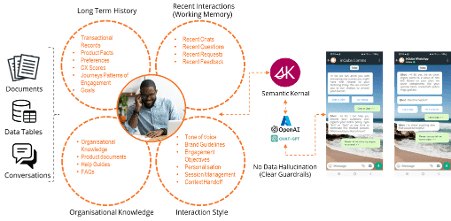
The end of 2024 is upon us. In our home market, the December period is a time for end of year holidays. Business shuts down and we head towards the coast or mountains to enjoy a break and welcome the new year.
This year will be remembered as a year of massive developments in AI. In particular, LLMs and generative AI have stood out as incredible new technologies that truly have become mainstream.
With the developments of AI, and reflecting on the very poor experiences that customers have had with Chatbots, it begs the question, why haven’t we seen dramatically better implementations of AI to service and guide customers?
I recently listened to a Podcast from the Chief Customer Officer of Verizon, Brian Higgins and a key discussion point was how Verizon is using AI to empower agents to be able to service customers. As the agent is interacting with the customer, content is presented that is relevant to the query. With the growing range of solutions and offerings within Verizon, it makes sense to help augment human agents with content that is relevant to the context of the situation. The situation still relies on an agent to apply reason and logic to interact with the end customer. The reason for this is that the agent deals with the context of the situation while the LLM deals with finding relevant content.
If you do a deep dive into AI and the latest developments, you will hear a lot about agentic AI. The basic application of AI makes use of a framework called RAG (Retrieval Augmented Generation). When combining agents with AI, the agent takes the power of generative AI a step further, because instead of just assisting you, agents can work alongside you or even on your behalf. Agents can do a range of things, from responding to questions to more complicated or multistep assignments. What sets them apart from a personal assistant is that they can be tailored to have a particular expertise. We can use the AI agent approach within the journey context.
The title of this newsletter is “AI Needs Context for Great CX. Journey is the Solution.” I would like to explain why I believe a journey centric approach is the perfect construct for customer engagement:
As we know, any interaction between two humans relies on the knowledge that exists between the two individuals. Individuals with a strong “relationship” really means that they have shared knowledge of past interactions. There is a mutual understanding and the conversion is effective because of a shared context that has been built up over time. Contrast that with a typical interaction with a Website chatbot. These chatbots (even with the latest generative AI) are “dumb”. They are perceived to be dumb because they have no context of the person that they are interacting with (the goldfish analogy comes to mind, on the basis that a goldfish supposedly has a 3 second memory).
There exits a unique opportunity to combine the following components to dramatically improve customer engagement:
- Long term knowledge of the customer
- Short term knowledge of the customer’s question or query
- A knowledge base that allows for retrieval of relevant content in the context of the above but is purely limited to that content and no other (preventing hallucinations)
- An interaction channel to engage with the customer
The solution is illustrated below:

Generative AI within Customer Journeys
Explaining the above concepts:
- The raw content comes in many forms : unstructured documents, structured data and past conversations (specific to the individual). This is the “raw input” required
- We then can arrange this content into different elements:
o The long-term history is everything we know about the customer that has been collected over time. This can include past interactions, products, demographics, patterns of interaction
o The company’s organisational information is as a source that will be served up to assist the customer. This can include the processes, products, rules and marketing material of the organisation.
o The most recent data collected must be prioritised in providing context as it has the highest relevance. This includes the specific questions, products and details of the most recent
o The interaction style and tone of the organisation is used to overlay the brand tone to be use when interacting with the customer. This is combined with the objectives of the interaction.
Journey is the perfect container to achieve the above as it has some unique capabilities:
- Customer Journey Management (CJM) solutions is time aware. Every element of interaction has a timestamp and thus interactions that are in close proximity can be differentiated from more distance context
- CJM solutions unify all interactions into a single view of the customer. Customer identification and unification is a cornerstone element of CJM solutions
- CJM solutions have well established interaction challenges that can engage at the right time in the journey
The process for engaging customers plays out as follows:
- A customer interacts with a brand
- At relevant points (determined by the journey timing, start and goal), customers either need to be nudged forward or information must be provided to the customer to unblock their progress
- The customer context stored against the customer is used to retrieve the most relevant content and it is formatted using the interaction guidelines and presented to the customer to drive the objective of the interaction.
The result is content that is context aware, highly personalised, timed appropriately and delivered through the interaction channel of choice.
We have already seen that simple rules based content leads to dramatically better results when driving customers along the customer journey. The augmentation of the generative AI capabilities will lead to even better results and ultimately better goal achievement.
As mentioned at the start of this newsletter, we are headed towards our summer holiday. That means less AI, more human interaction, more interaction with the physical world, while not missing the opportunity to both reflect on the year behind us and dream about what we plan achieve in the year ahead. The year has been a very exciting one for the inQuba team. We have achieved significant progress in the application of our Journey Management Concepts. We plan to accelerate these development into next year.
I trust that you have enjoyed the input, perspectives and experiences in driving Customer Journey management. Please share your perspectives – it would be great to hear from you.
Have a brilliant week ahead and as always enjoy the journey
Connect with us
Find out how inQuba can help you transform your customer engagement strategy.
About inQuba Journey Management
Customer Journey Management is revolutionizing how businesses engage with their customers. Like a precision tool, it offers targeted, data-driven insights into specific customer cohorts, behaviors, and use cases, allowing you to act with accuracy and purpose. Unlike traditional CX approaches, which can sometimes yield flat results, our Journey Management solution combines Journey Analytics and Journey Orchestration to deliver a comprehensive view of your customers’ actual journeys.
With inQuba, you can visualize real customer journeys, understand the emotional drivers behind their actions, dynamically remove obstacles, and provide timely, personalized nudges to guide them toward desired outcomes. This strategic approach has proven to double customer conversion rates, transforming both customer experiences and business growth.
We’d love to learn more about your business challenges and discuss how inQuba Journey Management can empower your organization to achieve its goals. Reach out today to find out how we can assist you.


